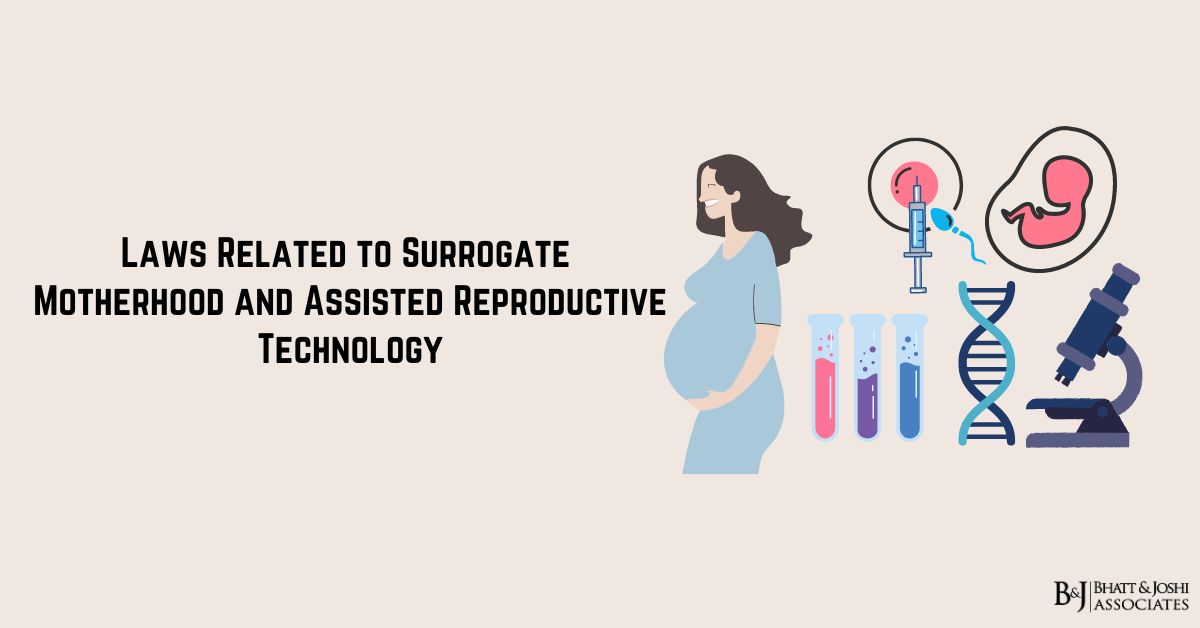Introduction
Surrogate motherhood and assisted reproductive technology (ART) represent two significant advancements in reproductive medicine. These technologies have revolutionized the way society perceives parenthood and family structures. However, these advancements come with complex legal, ethical, and moral dilemmas. Addressing the regulation and legal status of surrogacy and ART is crucial to ensure that these practices operate ethically and are accessible to those in need while protecting the rights of all parties involved. Surrogacy involves a woman, known as the surrogate, carrying a pregnancy for another person or couple, typically referred to as the intended parents. ART encompasses a wide range of medical techniques used to assist individuals or couples in achieving pregnancy. These technologies include procedures like in vitro fertilization (IVF), intrauterine insemination (IUI), egg and sperm donation, and embryo transfer. The intersection of surrogacy and ART raises several legal and ethical questions concerning the regulation of the medical industry, the rights of surrogates and intended parents, and the welfare of children born through these methods. Globally, the legal frameworks governing surrogacy and ART vary widely. While some countries have embraced these practices with regulated frameworks, others have banned or severely restricted them, citing ethical concerns. In India, surrogacy and ART have undergone substantial legal reforms, particularly with the enactment of the Surrogacy (Regulation) Act, 2021, and the Assisted Reproductive Technology (Regulation) Act, 2021. These laws aim to prevent exploitation and regulate the fertility industry, ensuring ethical practices are followed.
Surrogate Motherhood: Legal Framework and Regulation
Surrogate motherhood involves a woman (the surrogate) carrying and delivering a child for another person or couple (the intended parents). The legal landscape surrounding surrogacy varies widely across jurisdictions.
International Perspectives
United States: The U.S. presents a diverse regulatory environment for surrogacy. States like California and Illinois offer comprehensive legal frameworks supporting surrogacy agreements, including provisions for surrogate compensation and the enforceability of contracts. In California, for example, the Uniform Parentage Act provides a legal basis for enforcing surrogacy agreements, ensuring that both surrogate and intended parents have clear legal rights and responsibilities.
Conversely, states like New York and Michigan have more restrictive or prohibitive approaches. New York, historically known for its restrictive surrogacy laws, has seen recent legislative changes. For instance, the New York State Legislature passed the Child-Parent Security Act in 2020, legalizing compensated surrogacy and establishing protections for surrogates and intended parents.
United Kingdom: The UK regulates surrogacy through the Human Fertilisation and Embryology Act 1990. The Act permits altruistic surrogacy but bans commercial surrogacy. The Human Fertilisation and Embryology Authority (HFEA) oversees surrogacy arrangements, ensuring compliance with legal standards and protecting the interests of surrogates and intended parents.
France and Germany: Both countries have restrictive surrogacy laws. France prohibits all forms of surrogacy, reflecting a stance against the commercialization of reproductive services. Germany’s regulations are similarly restrictive, banning commercial surrogacy and placing strict limitations on altruistic arrangements. These regulations aim to prevent potential exploitation and ensure ethical practices in reproductive medicine.
Indian Legal Framework
India’s regulatory approach to surrogacy has evolved significantly with the introduction of the Assisted Reproductive Technology (Regulation) Act, 2020. This Act provides a comprehensive framework for surrogacy and Assisted Reproductive Technology practices.
Regulatory Provisions: The Act permits only altruistic surrogacy and bans commercial surrogacy. It requires surrogacy agreements to be formalized in writing, detailing compensation, medical care, and custody of the child. The Act also stipulates that surrogates must be between 25 and 35 years old, have at least one live birth, and may not serve as a surrogate more than once.
Intended Parents: The Act mandates that intended parents must be legally married for at least five years or in a long-term relationship, with medical proof of infertility. This requirement aims to ensure that surrogacy is pursued for legitimate reasons.
The Evolution of Surrogacy and Assisted Reproductive Technology in India
India has historically been a hub for surrogacy, particularly for international intended parents. The absence of clear legal regulations in the early 2000s led to a rise in commercial surrogacy, where surrogates were often economically disadvantaged women who offered their services for a fee. This phenomenon gave rise to ethical concerns, including the commodification of women’s bodies, exploitation, and concerns over the welfare of the surrogate and the child.
The landmark case of Baby Manji Yamada v. Union of India (2008) highlighted the legal vacuum surrounding surrogacy in India. In this case, a Japanese couple commissioned a surrogate in India. However, before the child was born, the couple separated, leaving the child’s legal status in question. The Supreme Court of India ruled that the child was entitled to Indian nationality and that the intended father could seek custody. This case underscored the need for regulatory clarity in surrogacy arrangements.
The growing prevalence of commercial surrogacy and the involvement of foreign nationals eventually led to calls for more stringent regulation. In 2015, the Indian government banned foreign nationals from commissioning surrogacy services, aiming to curb the exploitation of Indian women and address the ethical concerns surrounding cross-border surrogacy arrangements.
The Surrogacy (Regulation) Act, 2021
The Surrogacy (Regulation) Act, 2021, marks a significant turning point in India’s legal approach to surrogacy. The Act restricts surrogacy to altruistic arrangements and bans commercial surrogacy entirely. This move was made to prevent the commodification of women’s bodies and safeguard surrogates from exploitation. Under the Act, a surrogate mother can only be compensated for her medical expenses and health insurance coverage, eliminating the financial incentives that once drove commercial surrogacy in India.
Altruistic Surrogacy Provisions
Altruistic surrogacy, as defined in the Surrogacy Act, refers to an arrangement in which the surrogate mother carries a child for the intended parents without receiving any financial compensation other than for medical and related expenses. The Act imposes several strict eligibility criteria for both the surrogate mother and the intended parents.
The intended parents must:
- Be Indian citizens.
- Be a heterosexual couple married for at least five years.
- Have a proven medical condition that necessitates surrogacy as the only means of having a child.
- Not have any surviving biological or adopted children (with certain exceptions for disabled or special needs children).
The surrogate must:
- Be a close relative of the intended parents.
- Be married and have at least one biological child of her own.
- Be within a specific age range (25-35 years for the surrogate mother).
- Provide written consent for the surrogacy arrangement.
Furthermore, surrogates are only permitted to undertake surrogacy procedures once in their lifetime, a provision designed to protect their health and well-being. The Act also requires the establishment of a national surrogacy board to oversee surrogacy arrangements and ensure that surrogacy clinics adhere to ethical guidelines.
Commercial Surrogacy Ban
The Act’s ban on commercial surrogacy addresses concerns over the exploitation of poor women who were often coerced into surrogacy for financial reasons. Commercial surrogacy arrangements, where surrogates were paid substantial sums, had become a booming industry in India prior to the 2021 Act. Critics of commercial surrogacy pointed out that it often involved wealthy, foreign intended parents exploiting vulnerable Indian women, turning surrogacy into a transactional arrangement.
By restricting surrogacy to altruistic arrangements, the Act seeks to create a more ethical and regulated framework, where the focus is on the welfare of the surrogate and the child, rather than financial gain. However, the ban on commercial surrogacy has been met with criticism by some, who argue that it severely limits access to surrogacy for individuals who may not have a close relative willing to serve as a surrogate.
Penalties for Violating the Surrogacy Act
The Surrogacy (Regulation) Act imposes strict penalties for violations, including imprisonment for up to 10 years and fines for engaging in or promoting commercial surrogacy. Additionally, unregistered surrogacy clinics are prohibited from operating, and any clinic found engaging in unauthorized surrogacy practices faces legal consequences.
Assisted Reproductive Technology: Regulatory Landscape
ART includes procedures such as in vitro fertilization (IVF), gamete donation, and embryo transfer. The regulatory landscape for ART aims to address ethical concerns and protect patient rights.
International Standards
United Kingdom: The Human Fertilisation and Embryology Act 1990 establishes the HFEA to oversee ART practices. The Act provides a framework for regulating ART, including provisions for informed consent, embryo research, and patient privacy. Recent amendments have addressed new technologies, such as mitochondrial donation.
United States: ART regulation in the U.S. is characterized by a lack of federal oversight, with laws varying from state to state. The American Society for Reproductive Medicine (ASRM) provides guidelines, but these are not legally binding. State-specific regulations address issues such as patient consent and embryo disposal, resulting in significant variability.
Indian Regulatory Framework for Assisted Reproductive Technology
Assisted Reproductive Technology (Regulation) Act, 2020: This Act establishes a National ART and Surrogacy Registry to maintain records of ART procedures and surrogate arrangements. It regulates gamete and embryo donation, requiring informed consent and confidentiality. The Act also mandates operational standards for ART clinics, ensuring high standards of care and preventing misuse.
Regulation of ART Clinics
Under the ART Act, all ART clinics and banks must be registered with the appropriate regulatory authorities. This ensures that only certified clinics with trained medical professionals are allowed to offer ART services. The Act mandates that ART clinics maintain comprehensive records of patients, donors, and procedures, and that these records be made available to the regulatory authorities for inspection.
Rights of Donors
The ART Act also addresses the rights of sperm and egg donors. It mandates that donors must provide informed consent before participating in ART procedures, and that their identities remain confidential unless disclosure is required by law. The Act prohibits the sale or purchase of gametes and embryos, making it illegal to commodify reproductive materials.
Donors are also protected from exploitation under the ART Act. The law ensures that donors are not coerced or pressured into donating gametes, and that they are compensated only for medical expenses and not for the donation itself. This provision seeks to prevent the commercialization of gametes, a common ethical concern in ART practices.
Prohibition of Sex Selection
One of the critical aspects of the ART Act is its prohibition on sex selection. In India, where the cultural preference for male children has historically led to gender imbalances, the government has enacted strict laws to prevent sex-selective practices. The ART Act aligns with the Pre-Conception and Pre-Natal Diagnostic Techniques (Prohibition of Sex Selection) Act, 1994, which makes it illegal to use ART procedures for the purpose of selecting the sex of a child.
Landmark Cases of Assisted Reproductive Technology and Surrogacy Laws in India
Indian courts have consistently shaped the legal interpretation of surrogacy and ART practices through landmark judgments. These judicial pronouncements have clarified complex legal questions regarding the rights of intended parents, surrogates, and children born through ART.
In the case of Baby Manji Yamada v. Union of India (2008), the Supreme Court of India addressed the legal challenges surrounding surrogacy when the intended parents separated before the child was born. The court ruled that the child had the right to Indian citizenship and clarified the legal responsibilities of the intended father. This case set a precedent for future surrogacy arrangements by emphasizing the need for legal clarity in cross-border surrogacy.
Another important case, Jan Balaz v. Anand Municipality (2010), dealt with the issue of citizenship for children born to foreign nationals through surrogacy in India. The Gujarat High Court ruled that the children were entitled to Indian citizenship since they were born to an Indian surrogate mother. This case highlighted the complexities of cross-border surrogacy and the importance of clearly defined legal frameworks to address issues of nationality and parental rights.
Global Perspectives on Surrogacy and Assisted Reproductive Technology Regulation
Surrogacy and ART are regulated differently around the world, reflecting varying cultural, ethical, and legal perspectives. In countries like the United States, surrogacy laws vary from state to state. California is known for its permissive surrogacy laws, allowing both commercial and altruistic surrogacy. However, other states, such as Michigan, have banned surrogacy altogether.
In Europe, many countries have taken a more restrictive approach to surrogacy and ART. Countries like Germany, France, and Italy prohibit surrogacy in all forms, citing ethical concerns over the commodification of women and the potential for exploitation. On the other hand, countries like Ukraine and Georgia have more permissive surrogacy laws, which has led to an increase in international surrogacy arrangements.
The absence of uniform global regulations for surrogacy and ART has created challenges for cross-border surrogacy arrangements. Issues of citizenship, parental rights, and legal responsibilities often arise in these situations, requiring international cooperation and legal clarity.
Ethical and Social Challenges in Surrogacy and Assisted Reproductive Technology
Surrogacy and ART raise several ethical challenges that necessitate legal intervention. One of the primary concerns is the exploitation of surrogate mothers, particularly in countries where economic disparities may compel women to enter into surrogacy for financial reasons. Critics argue that commercial surrogacy commodifies women’s bodies and turns childbirth into a transactional arrangement, where the interests of the surrogate are often secondary to those of the intended parents.
Another ethical challenge concerns the rights of children born through surrogacy and ART. These children may face legal and social challenges regarding their parentage, citizenship, and right to know their biological origins. Additionally, ART procedures that involve the use of donor gametes raise questions about the rights of donors and the anonymity of genetic parentage.
The issue of reproductive autonomy is also at the forefront of ethical debates surrounding ART and surrogacy. In countries where surrogacy is restricted to heterosexual married couples, individuals from marginalized groups—such as same-sex couples, single parents, and transgender individuals—are often excluded from accessing these reproductive technologies. This raises concerns about equality and non-discrimination in reproductive health care.
Conclusion
The laws governing surrogacy and assisted reproductive technology are constantly evolving to address the complex legal, ethical, and social challenges posed by these practices. In India, the Surrogacy (Regulation) Act, 2021, and the Assisted Reproductive Technology (Regulation) Act, 2021, represent significant efforts to regulate these practices and ensure that surrogacy and ART are conducted ethically, transparently, and with respect for the rights of all parties involved.
As technology continues to advance and societal attitudes toward family and reproduction evolve, the law must adapt to ensure that surrogacy and ART operate within a framework that safeguards human dignity, protects vulnerable individuals, and upholds the rights of children. The challenges posed by surrogacy and ART are global in nature, requiring not only national regulatory frameworks but also international cooperation to address cross-border surrogacy arrangements and the complexities of ART services.














